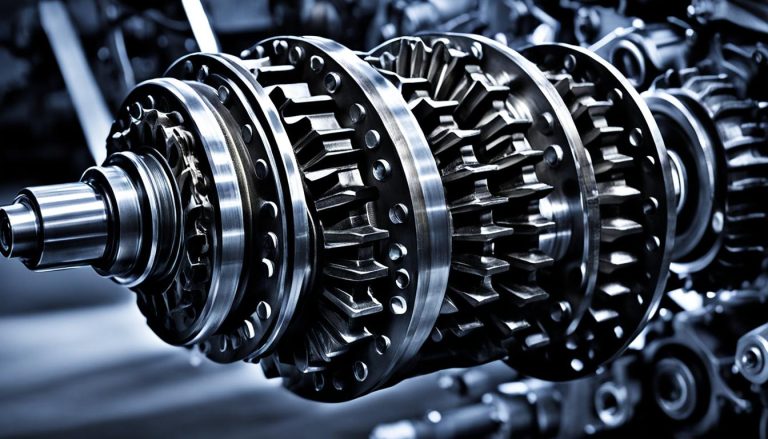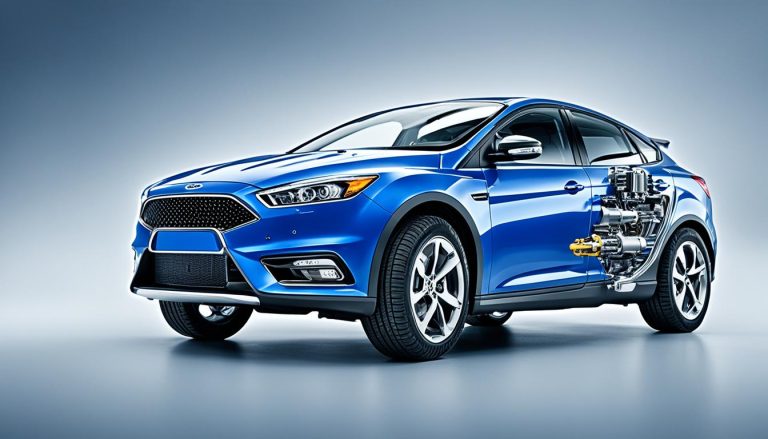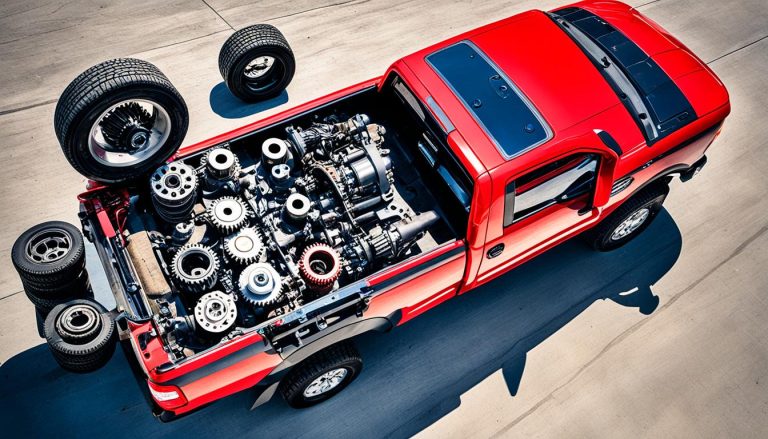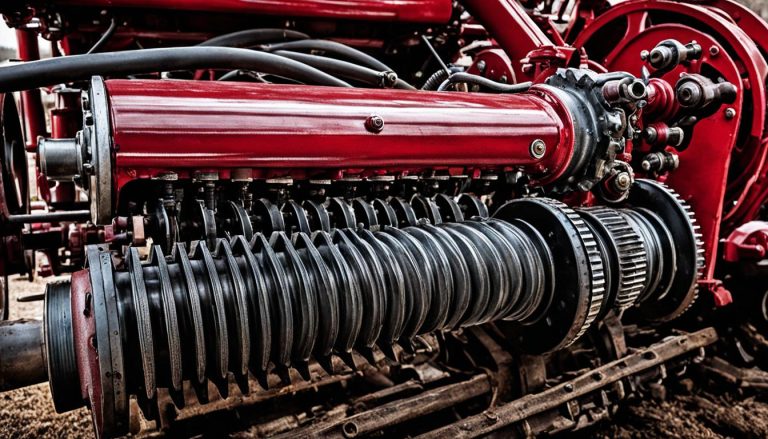Farmall 349 Rear End: Limited Slip or Posi Traction?
If you’re in the market for a Farmall 349 or already own this sturdy piece of agricultural machinery, you might be wondering about the specifics of its rear differential. Your Farmall 349’s rear end is a critical factor in how your tractor performs, especially when it comes to handling and power distribution across its rear wheels. Whether the system is equipped with a limited slip or possesses posi traction capabilities can greatly influence your tractor’s efficiency and stability on various terrains.
Understanding the dynamics of the Farmall 349 rear differential is not just for the mechanically inclined. It’s practical knowledge that enhances your machine’s reliability and ensures your operations run smoothly—no matter the ground underneath. With this in mind, let’s delve into the world of traction control systems and their significance to your Farmall 349 rear end.
Does your Farmall 349 operate with a rear end limited slip differential for even power distribution, or does it boast the heightened grip of a posi traction setup? Knowing this can decide how effectively you can work your land and how adaptable your tractor can be to changeable conditions. So, buckle up as we guide you through the inner workings of the Farmall 349 rear end, ensuring you get the most out of your tractor.
Key Takeaways
- Knowing the type of differential—limited slip or posi traction—can influence your tractor’s handling on your terrain.
- The Farmall 349 rear end plays a significant role in the vehicle’s performance and stability under various conditions.
- A better understanding of your Farmall 349 rear differential will help you maintain it for reliable operations.
- Evaluate your tractor’s rear end to decide if it meets your agricultural demands or if an upgrade is in order.
- Keep the concepts of limited slip and posi traction in mind when considering the efficiency and safety of your farming tasks.
Farmall 349 Rear End: Understanding Your Tractor’s Differential
You’ve experienced the Farmall 349’s sturdy build and dependable engine, but let’s delve deeper into the critical component that is the rear end differential. This remarkable piece of engineering is what puts the power of your tractor where it matters: in the wheels that drive your agricultural ambitions forward.
The Function of a Rear Differential in Tractors
Imagine turning a corner smoothly and efficiently—this is the magic the rear differential brings to your tractor’s performance, allowing the outer wheel to rotate faster than the inner wheel. It’s not just about turning corners though; it’s about maintaining control and stability on various landscapes around your farm.
Exploring the Farmall 349’s Power Transfer Capabilities
Power transfer is no small feat when you’re maneuvering a machine like the Farmall 349. With optimal tractor performance hinging on the proficiency of power transfer, the differential ensures that even when pulling heavy loads across uneven terrain, your tractor won’t miss a beat. This is key in scenarios where farmers require the certainty of traction and the assurance of unyielding drivability.
When considering an upgrade such as a farmall 349 rear end upgrade, think about the essentiality of each option available. Do you need more traction for wet conditions, or are you looking for something that will better handle the load distribution for the long haul? Understanding your Farmall 349’s rear end options will provide insight into which configuration aligns with your distinct agricultural requirements.
Is Farmall 349 Rear End Limited Slip or Posi Traction
As a vital part of your Farmall 349’s performance, the rear end differential can be a game changer when it comes to tackling different agricultural tasks. Knowing whether your tractor has a limited slip or posi traction system is key to leveraging its capabilities to the fullest. Let’s dive into the characteristics of the Farmall 349 rear end to clear up some common questions you might have.
The term “posi traction” typically refers to a type of limited slip differential, which means that although the terms are often used interchangeably, they tend to describe the same functional concept. This system is designed to improve traction by distributing power to the wheel with the most grip. However, the specifics can vary, so knowing the exact type installed in your Farmall 349 can impact your approach to various farming conditions.
To simplify this, consider how each system operates under challenging conditions:
- Limited Slip Differential: Automatically directs more power to the wheel that has more traction, reducing wheel spin and improving control.
- Posi Traction: Typically used to describe a General Motors branded limited slip differential, but generally, it functions to keep wheels in lock-step to avoid slipping.
Therefore, if you’re working on slippery surfaces or performing tasks that require precision handling, understanding these characteristics is essential. Farm operations often involve varying terrains and weather conditions, making the choice between a limited slip and posi traction rear end a strategic decision for your agricultural needs.
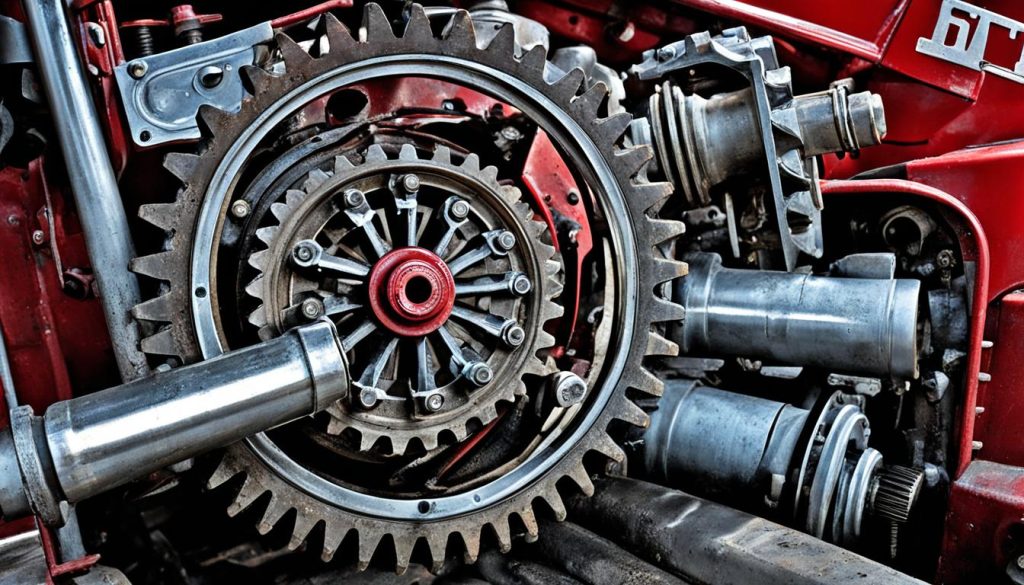
While specifics on the Farmall 349 rear end can be intricate, farmers should pay attention to the individual needs of their operation. Whether you’re ploughing a wet field or hauling a heavy load on uneven ground, the differential you rely on should be up to the task. If you’re considering an upgrade or are simply curious about your tractor’s existing setup, a close examination of your Farmall 349 rear end characteristics should be on your to-do list.
Here’s a brief checklist to guide you through understanding the rear end of your Farmall 349:
- Review your Farmall 349 tractor’s manual or contact your dealer for detailed specifications.
- Inspect your tractor’s rear end differential for any model-specific labels or identification marks.
- Consider the most common tasks your tractor performs and match those needs with the appropriate rear end features.
- If an upgrade is in order, research available options that can retrofit your current setup for improved performance.
In conclusion, whether your Farmall 349 is equipped with a limited slip differential or with posi traction capabilities, the key lies in how it meets the demands of your specific agricultural applications. By understanding and possibly enhancing your tractor’s rear end, you’re not just maintaining it; you’re maximizing its potential.
Analyzing the Farmall 349 Rear End Options for Optimal Performance
As you dive into the specifics of your Farmall 349 tractor, you’ll find that the key to superior control and efficiency lies in the rear end. Choosing between a farmall 349 rear end limited slip and farmall 349 rear end posi traction could greatly influence your tractor’s capability, especially in challenging conditions.
Before delving into the differences between the two systems, let’s place them side by side for a clearer picture.
Comparing Limited Slip and Posi Traction Benefits
A limited slip differential is often prized for its balanced power distribution to the wheels, crucial when negotiating slick or unstable grounds. Posi traction, on the other hand, is celebrated for its assertive traction, maintaining a firm grip when your tasks demand the most from your tractor.
Here’s a closer look at both systems:
- Limited Slip: Delivers improved traction without compromising the ability to maneuver. This system automatically directs power to the wheel with the most grip.
- Posi Traction: Known for a more robust engagement, it locks both wheels to rotate at the same speed, which is essential when both power and traction are non-negotiable.
Understanding these can significantly affect your choice, especially when considered alongside your specific agricultural needs.
Upgrading Your Farmall 349 Rear End for Enhanced Traction
Considering a rear end upgrade could be the best course of action for optimizing your Farmall 349’s performance. Upgrades can introduce remarkable traction enhancement, thus aiding in managing heavier loads and mastering uneven terrains.
| Rear End Option | Benefits | Best For |
|---|---|---|
| Farmall 349 Limited Slip | Even power distribution, better control on slippery surfaces | Tasks requiring finesse and precise maneuverability |
| Farmall 349 Posi Traction | Aggressive traction, locked wheel rotation | Demanding jobs where maximum power is needed |
| Custom Rear End Upgrade | Customized to your specific work requirements | Tailored tasks, diverse terrains, and unique working conditions |
Whether you’re considering bolstering your tractor’s capability through an aftermarket solution or weighing the benefits of what your Farmall 349 already offers, understanding these options is instrumental for maximizing productivity and ensuring safety.
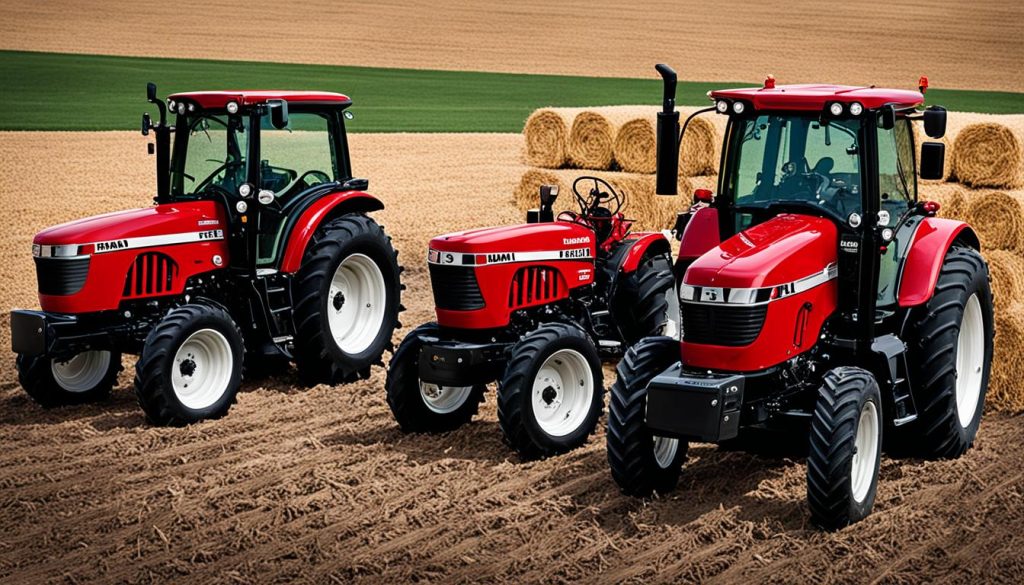
The Impact of Traction Technology on Modern Tractors
As you look out across your fields, the revolution of modern agriculture is underfoot—quite literally. Advances in traction technology have been paramount in shaping the efficiency and productivity of today’s farming. As your tractor moves across the terrain, it’s worth noting how the foundations of traction have come a long way.
The Evolution of Tractor Traction Over the Years
From the steel-wheeled behemoths of the early 20th century to the sophisticated machinery of today, tractor traction has undergone profound changes. These changes reflect continuous innovation in agricultural machinery trends, with a strong focus on improving soil interaction, minimizing compaction, and optimizing power. The shift from mechanical to hydrostatic transmission, for one, marks a significant leap forward in modern tractor traction. The advent of smart systems has also brought traction control to a new level, with sensors and electronic aids assisting in delivering the perfect amount of grip when and where it’s needed. This progress not only boosts efficiency but also plays a critical role in soil health, a key concern for sustainable farming practices.
How Farmall 349’s Rear End Technology Fits into Current Trends
The Farmall 349 rear end upgrade embodies these latest trends in traction technology, combining time-tested mechanics with new insights. Ensuring the power is transferred effectively to the ground, these upgrades cater to the demands for better traction and control. Tractors like the Farmall 349 are now equipped with rear ends that support greater weight, pull heavier implements, and traverse challenging terrain without a hitch. This alignment of the rear end technology with the modern needs of farmers spotlights the dynamic nature of agricultural machinery trends. Such enhancements are not only about raw power; they’re about translating that power into tangible results on your farm.
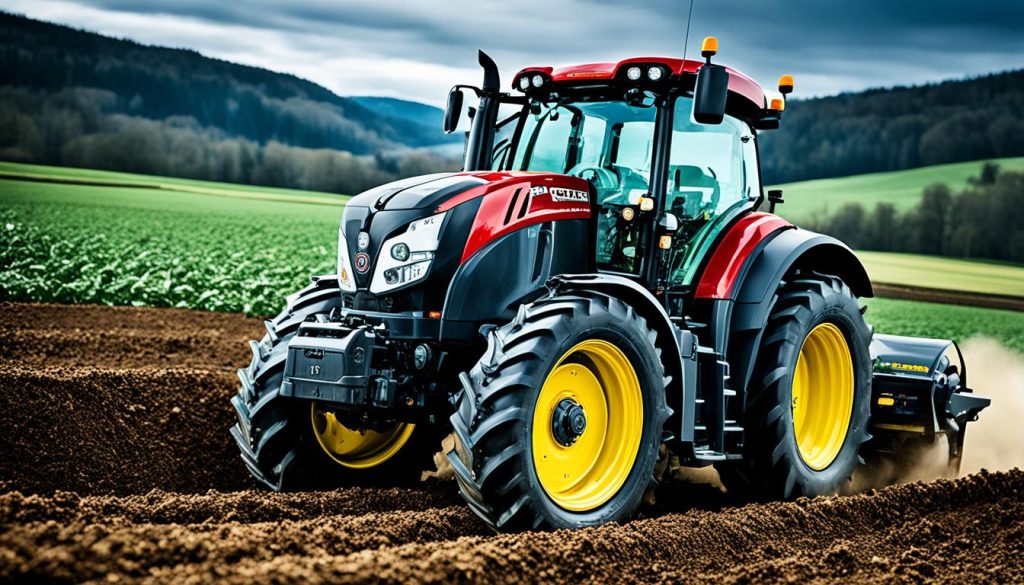
Upgrading to a more advanced rear end, like the one found in Farmall 349, translates into tangible benefits on the field. Traction technology improvements in agricultural machinery drive forward not just the tractors themselves, but the entire farming industry, pushing boundaries and establishing new benchmarks for what can be achieved with the right equipment. Keep an eye on the horizon, because if history is any indication, the future of tractor traction is sure to bring even more exciting developments your way.
Farmall 349 Rear End Limited Slip and Posi Traction: A Closer Look at Mechanics
As a farmer, your equipment is your lifeline, and the Farmall 349 rear differential lies at the heart of your tractor’s performance. With cutting-edge rear end mechanics, it holds the key to superior traction control and stability in agricultural machinery. Let’s delve into the complexities that afford your machinery the robustness required for steadfast operation on the farm.
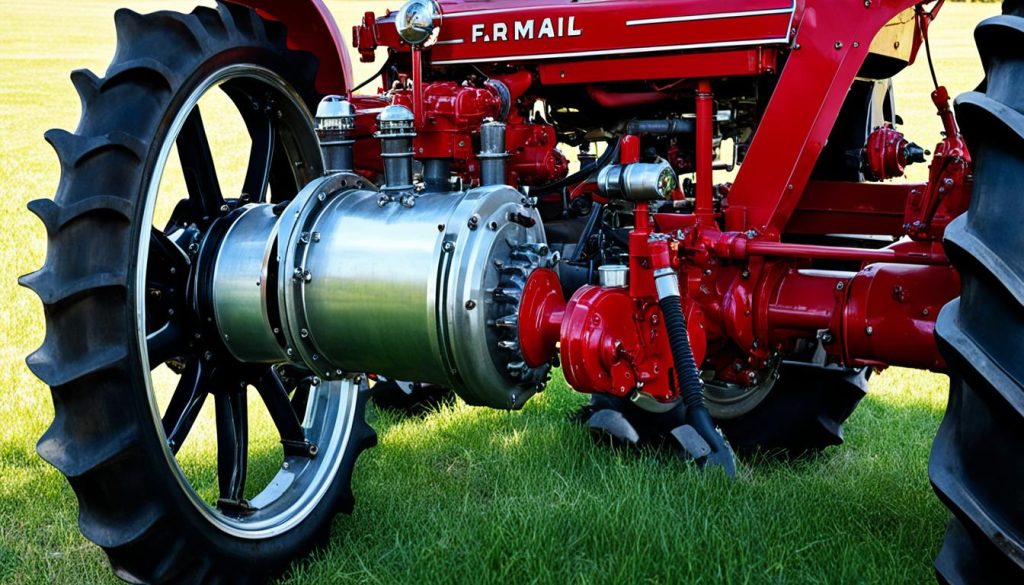
Internal Construction: Gearing Up for Ground Engagement
The internal architecture of the Farmall 349’s differential is engineered for optimized ground engagement. A sophisticated arrangement of gears interlocks to confer a fine balance of strength, responsiveness, and finesse. This equilibrium is pivotal as it determines how well torque is allocated across the wheels—a factor that directly influences your tractor’s performance on varying terrains.
Mechanical Synergy: Merging Strength with Stability
In the realm of farming mechanics, the confluence of power and stability is essential. The Farmall 349’s rear end emerges as a paragon of this mechanical synergy, marrying the raw force required to navigate tough agricultural settings with the stabilizing force needed for intricate maneuvers. It’s the harmony between the limited slip and posi traction frameworks that imbues the Farmall 349 with a notable edge in operational efficacy.
Whether you’re entrenched in everyday farm work or facing the unpredictability of nature, understanding your tractor’s underpinnings not only enhances your operational capacity but also empowers you with the insight to make decisions that elevate your agricultural practice.
Maintaining Your Farmall 349 Rear End for Lasting Durability
For the longevity and consistent performance of your Farmall 349, a steadfast commitment to regular rear end maintenance is essential. The rear differential is the backbone of your tractor’s mobility and, when well-cared for, contributes significantly to the **tractor’s durability**. It starts with simple habits such as monitoring differential fluid levels and lubricating moving parts which translate into substantial benefits over the tractor’s lifespan.
Regular Maintenance Schedule for Farmall 349 Rear End
Creating and adhering to a **differential maintenance schedule** is a proactive step towards averting unexpected downtimes and costly repairs. Your Farmall 349 relies on you to periodically verify fluid levels and assess for any signs of wear or damage. It’s not just about keeping it running; it’s about preserving the precision and power that you depend on for those long days in the field. By setting regular intervals to inspect and service your tractor’s rear end, you contribute to a well-oiled engine of agriculture.
Common Issues and Solutions for Rear End Differentials
Yet, even with the best maintenance plan, you might encounter issues. It is normal; wear and tear are constants in the tough farming environment. But, knowledge is power when resolving rear end issues. Should you come across any irregular noises, difficulty in handling, or spotting a leak, it’s crucial to take swift action. From part replacements to fine-tuning your driving strategy, there are multiple ways to address problems. Remember, your prompt response is not only about fixing an issue but about fostering a culture of care that sees your Farmall 349 through many successful harvests.
FAQ
Does the Farmall 349 have a limited slip or posi traction rear end?
The Farmall 349 is equipped with a differential that functions similarly to a limited slip system, providing posi traction capabilities for even power distribution and improved traction under various conditions.
What is the function of the rear differential in a Farmall 349 tractor?
The rear differential in a Farmall 349 tractor is responsible for transferring power from the engine to the rear wheels, balancing wheel speed during turns, and providing necessary traction for effective field operations.
How can I enhance the power transfer capabilities of my Farmall 349?
You can enhance the power transfer capabilities by considering a rear end upgrade, which may include installing higher-performance parts or adjusting the current differential setup to optimize traction and handling.
What are the benefits of limited slip versus posi traction setups on a Farmall 349?
Limited slip differentials are excellent for ensuring power distribution to both wheels when traction loss occurs, which is beneficial on slippery surfaces. Posi traction systems aggressively maintain grip, which could be advantageous for demanding tasks and heavy-duty agricultural work.
Can I upgrade my Farmall 349 with a limited slip or posi traction system?
Yes, it is possible to upgrade your Farmall 349 with a system that provides either limited slip functionality or enhances its posi traction capabilities, depending on your needs and the intended usage of your tractor.
How have advancements in traction technology affected modern tractors like the Farmall 349?
Modern advancements in traction technology have improved the efficiency, stability, and safety of tractors, including the Farmall 349. These improvements ensure that tractors can perform more reliably even in challenging conditions.
What internal construction aspects of the Farmall 349’s rear end contribute to efficient ground engagement?
The gearing system within the Farmall 349’s differential plays a significant role, providing the necessary strength and stability to distribute torque between wheels while accommodating for differences in rotation during turns.
What regular maintenance should be performed on the Farmall 349 rear end?
Regular maintenance for the Farmall 349 rear end includes checking and maintaining differential fluid levels, inspecting for leaks or damage, and keeping all components well-lubricated to prevent common issues and ensure lasting durability.
What are some common issues and solutions associated with rear end differentials?
Common issues with rear end differentials include premature wear, unusual noises, or ineffective power transfer. Solutions range from replacing worn parts to seeking professional maintenance services to ensure proper function.

